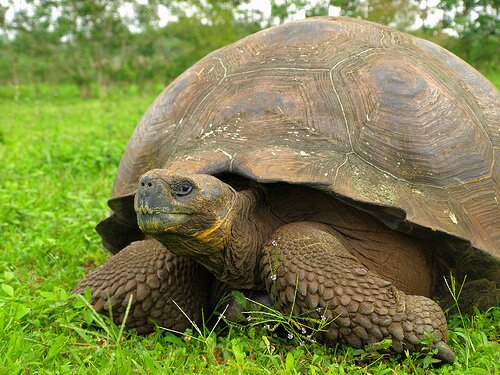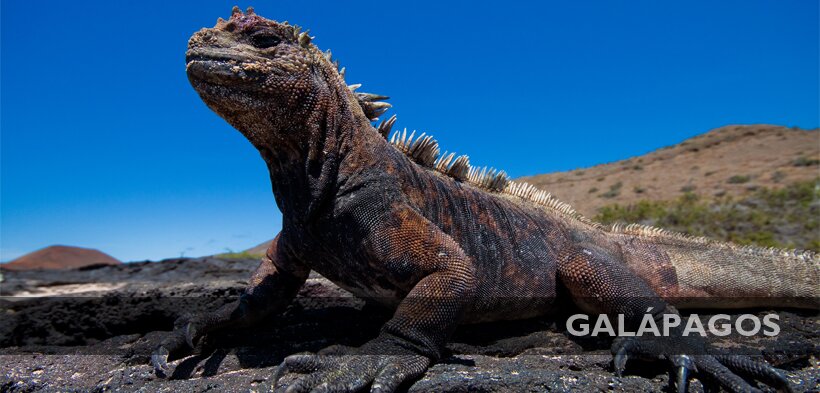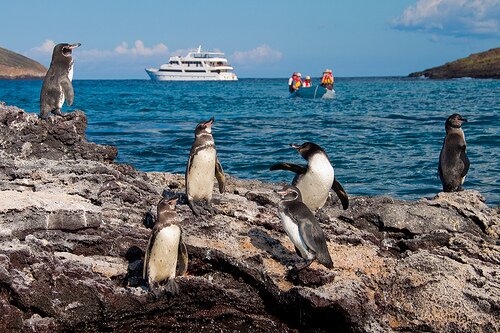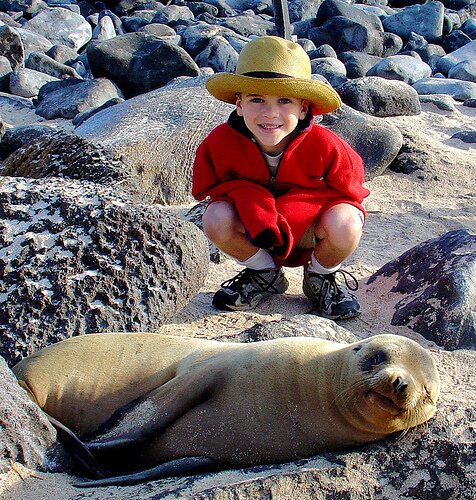Vea esta publicación en español.
The Galapagos Islands, an archipelago of volcanic islands located 656 miles off the coast of Ecuador, are famous for their stunning and well preserved natural beauty, including a large number of endemic species that are some of the world's most exotic animals.
Today we present five of the most famous animals that are unique to the Galapagos:
1. Giant tortoise (Chelonoidis nigra)
 |
|
These are the largest turtles in the world and among the longest living. The largest Galapagos giant tortoise measured almost 6 feet and weight over 880 lbs. They can live over 100 years in the wild while captive individuals have been known to reach 170 years. Today there are only 11 kinds of giant tortoise in the Galapagos, down from 15 when Darwin arrived, and about 15,000 individuals total. All are threatened with extinction. One interesting fact: these huge, peaceful creatures can rest for up to 16 hours per day. |
2. Marine iguanas (Amblyrhynchus cristatus)
 |
|
The Galapagos is home to the only marine iguana in the world! These curious animals live on land but feed on a wide variety of algae on rocks in the sea, either skimming near the surface or diving more than 30 feet (9 m) deep. They can remain underwater for up to 45 minutes, until their body can no longer withstand the cold temperature. It is said that these animals are an excellent example of adaptation. When algae are scarce, they have been seen eating crustaceans, grasshopers, and even terrestrial plants. When even those foods are hard to find, like during severe weather events associated with El Niño, the marine iguanas become thinner and shorter. Marine iguanas have an exotic Jurassic appearance. Males are about 4-5 feet long and females about 2 feet. According to the IUCN, the population of Galapagos marine iguanas consists of approximately 50,000 individuals and is threatened by pollution and predation by exotic species on the islands. |
3. Galapagos penguin (Spheniscus mendiculus)
 |
|
These penguins are the only wild endemic species that live north of the Equator in the Galapagos. They are descendants of a small group of extinct Humboldt penguins that scientists believe were carried to the Islands by the Humboldt Current, which originates in Antarctica and flows north along the west coast of South America from the southern tip of Chile to northern Peru. Unlike other penguins, they can have up to three breeding periods per year, thanks to abundant food (fish and crustaceans) in the islands. They usually lay two eggs and incubate them for about 40 days. Approximately 1,000 individuals of this species live on the islands and they are classified as endangered on the IUCN Red List. The Galapagos penguin is the world's third smallest penguin at only 20 inches tall approximately. In Spanish, they are called pájaro bobo, which means "silly bird." |
4. Flightless cormorant (Phalacrocorax harrisi)
 |
|
Also called the flightless cormorant of the Galapagos, this large endemic bird is unique because it is the only cormorant that has lost the ability to fly. These birds evolved in an isolated island environment that was free of predators. By gradual evolution, they felt no need to fly and eventually lost their flight. Their wings became greatly reduced, measuring only one-third of the area that would be necessary for a bird of its size to fly. These birds live on the rocky shores of the volcanic islands they inhabit, where they fish for eels, small octopuses, fish, and other aquatic creatures. Their population is estimated at around 900 individuals. |
5. Galapagos sea lion (Zalophus wollebaecki)
 |
|
These sea lions are among the largest animals of the Galapagos. They can weigh up to 550 lbs! They are a favorite among tourists, who see them lying on rocks, piers, and even benches near the beaches. Galapagos sea lions are very friendly, and it is safe to dive and swim near them as long as you don't disturb them. However, it is common for groups of sea lions to fight each other over territory. Females give birth to one pup per year and care for them until they are two or three years old. Females live longer than males--up to 20 years. The Galapagos is home to about 50,000 sea lions. |
The unique wildlife of the Galapagos is part of what makes this destination so special--and fragile as well. To protect these and other important species, tourists are only allowed to visit the Islands with a licensed tour company. Check out these sustainable tourism business in the Galapagos and plan the trip you'll never forget!


